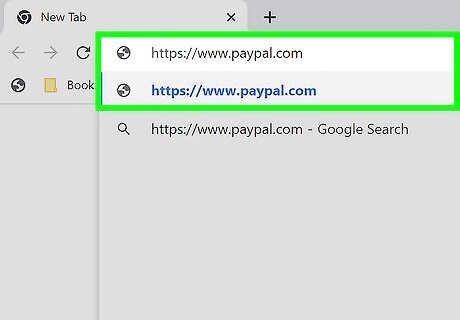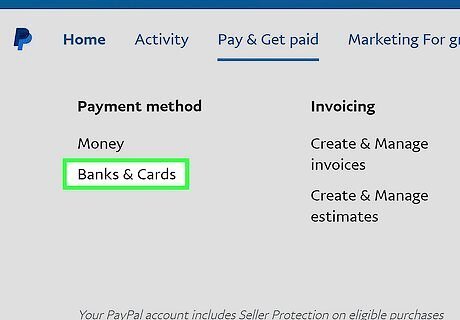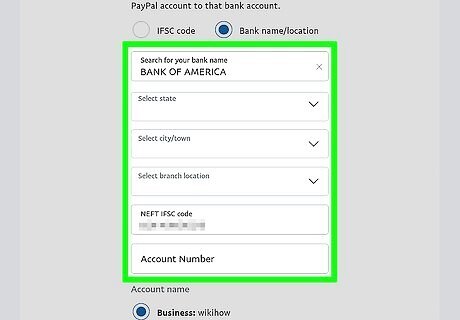
views
Signing Up

Go to https://www.paypal.com in a web browser. You can use any web browser, like Google Chrome, to create your PayPal account. If you'd prefer to use a mobile app on your Android, iPhone, or iPad, download the official PayPal app from the Apple App Store or Google Play Store. You can also sign up for PayPal when checking out on a website that accepts PayPal. Just click the PayPal button on the online store to get started.

Click Sign Up. You'll see this blue button at the top-right corner of the page.

Choose an account type and click Get Started. When signing up for PayPal, you'll have two account type options: Personal accounts are best for most people. They allow you to send and receive payments and shop wherever PayPal is accepted. To create a personal account, you'll need to provide your full name, address, phone number, and email address. You'll be able to receive payments right away. If you want to send money or make payments, you'll need to link your bank account or credit/debit card. If you run a business and want to accept PayPal at the register or on your website, select Business Account. You'll need to provide all of the same information as you would with a personal account, as well as your business EIN or SSN. You can convert a personal account to a business account later, but you can't change a business account back to a personal account.

Enter your email address and click Next. When creating a personal account, you'll need to provide a mobile phone number to verify your account. As soon as you click Next, PayPal will send a confirmation code to that phone number via SMS.

Enter your personal or business details and create a password. The information you'll need to enter will be a little different depending on the type of account you're creating. Enter all required information, including your full name and contact info, and create a secure password for your account. If you're creating a personal account, be sure to use your full legal name to avoid any issues transferring money to and from your bank account. If you're creating a business account, enter the address of your business and provide all additional requested details.

Follow the on-screen instructions to create your account. PayPal will walk you through the remaining steps of setting up and verifying your account. Once you agree to the terms, your PayPal account will be ready to use.
Adding a Payment Method

Sign in to your new PayPal account. If you're not already signed in, go to https://www.paypal.com and click Log In to sign in now. Once you add a payment method to PayPal, you can use it to send money. You can use PayPal without linking a bank account or debit card, but you'll only be able to send money to (and receive money from) other PayPal accounts. You can only transfer money from PayPal to your bank account if you've linked it.

Click the Wallet tab. It's at the top of the page on a computer and at the bottom of the PayPal mobile app. If you created a business account, click the Pay & Get Paid tab at the top and select Money from the menu.

Click Link a card or bank. This button is near the middle of the page. If you're using the mobile app, tap Add banks and cards at the top instead.

Choose the type of account you want to link. You can add multiple payment methods if you wish, but for now, start with one. The remaining options will vary slightly in wording in the mobile app, but they're generally similar. Click Link a debit card or credit card to link any payment card. This option is geared toward making purchases online. You can also use this option to add a prepaid gift card from Visa, MasterCard, American Express, or Discover. Click Link a bank account to link a bank account. This option lets you withdraw money from your PayPal account to your personal or business bank account. Click Amex Send Account if you have an Amex Send account you want to connect to PayPal.

Connect your payment method automatically (if available). If you chose to add a bank account or have a bank-issued debit or credit card, check to see if your bank is listed. You can use the search bar to search for it by name if you don't see its logo. If your bank is listed, select it, and follow the on-screen instructions to connect your bank account to PayPal.

Link your account manually (if needed). If your bank wasn't listed, you'll have to enter your account information manually: Use the search bar to search for your bank. If no options match, click Debit or credit card if you're linking a card, or Enter your bank details if linking a bank account. Checking or savings account: Type the account number and routing number when prompted. You'll find these numbers at the bottom of a check or on your banking statement. Debit or credit card: Type the card number, expiration date, 3-digit CVC code, and other info when prompted. Click Agree and Link (bank account) or Link Card(credit/debit card). If you entered your bank account number manually, check your bank account in 24-48 business hours. PayPal will make two small deposits into your account, totaling less than a dollar. You'll need to enter these two values to confirm that you are the owner of the bank account. To confirm your deposits after 2 business days, log back into PayPal, and click the red Confirm icon under your bank's name on the right side of the page. You can also click the Wallet tab, select your bank, and click Confirm bank. Enter the two amounts as they appear on your statement to confirm your account.




















Comments
0 comment